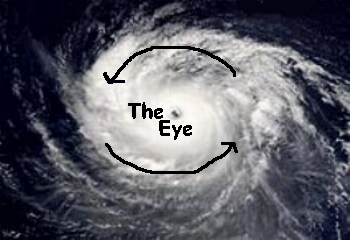What Causes Hurricane?
Posted by The New N Used Link Team on Tuesday, September 10, 2013 Under: Environment
Its the hurricane season and many people dont understand how it is formed and why it causes so much damage in certain countries.
Hurricanes
are intense low pressure
areas that form over warm ocean waters
in the summer and early fall. Their source of energy is water vapor
which is evaporated
from the ocean surface.
Water vapor is the "fuel" for the hurricanes because it releases the
"latent heat of
condensation" when it condenses to form clouds and rain,
warming the surrounding air.
(This heat energy was absorbed by the water vapor when it was
evaporated from the warm
ocean surface, cooling the ocean in the process.)
Usually, the heat released in this way
in tropical thunderstorms is carried away by wind shear,
which blows the top off the thunderstorms. But when there is little
wind shear, this heat can
build up, causing low pressure to form. The low pressure causes
wind to begin to spiral inward
toward the center of the low.
These winds help to evaporate even more
water vapor from the ocean, spiraling inward toward the center,
feeding
more showers and thunderstorms, and warming the upper atmosphere
still more. The showers
and thunderstorms where all of this energy is released are usually
organized into bands (sometimes
called "rainbands" or "feeder bands"), as well as into an "eyewall"
encircling the center of the storm.
The eyewall is where the strongest winds occur, which encircle
the warmest air, in the eye of the hurricane. This warmth in the eye
is produced by sinking air, which
sinks in response to rising air in the thunderstorms. The winds
diminish rapidly moving from the
eyewall to the inside of the relatively cloud-free eye, where calm
winds can exist.
In low-lying areas, much of the damage from hurricanes can be from
the "storm surge", in
which water being blown onshore by the high winds rises rapidly. The
storm surge can destroy the lower floors
of some buildings, or even destroy the foundations of residences
causing the homes to wash away.
The storm surge can also trap residents from evacuating along
low-lying escape routes. Hurricanes almost always travel poleward at the
end of their life
cycle, helping to transport excess heat out of the tropics toward
higher latitudes. Sometimes the hurricane will merge with an
extratropical (non-tropical) storm system, which can cause temporary
intensification of the storm.
Hurricanes gradually die as they move over cooler waters,
which do not have the heat
energy necessary to evaporate sufficient water vapor into the
atmosphere to fuel the hurricane. If
the hurricane crosses over to land, the heat source is removed
entirely. With the
removal of the energy source, and the greater surface friction of the
land's terrain and vegetation, the hurricane's winds rapidly decrease.
In : Environment

